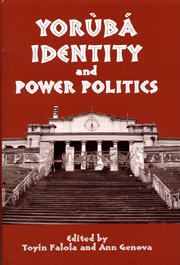Book contents
- Frontmatter
- Contents
- List of Illustrations
- Introduction
- Part I Writing Yorùbá
- 1 The Yorùbá Nation
- 2 Oral Tradition and the Reconstruction of Yorùbá Dress
- 3 Diaries as Cultural and Intellectual Histories
- 4 Historiography of Western Yorùbá Borderlands
- 5 The History of the Okun Yorùbá: Research Directions
- 6 Ìlá Kingdom Revisited: Recent Archaeological Research at Ìlá-Yàrà
- 7 Early Ìjѐbú History: An Analysis on Demographic Evolution and State Formation
- Part II Chiefs and Tradition
- Part III Identity and Modern Politics
- Notes on the Contributors
- Index
6 - Ìlá Kingdom Revisited: Recent Archaeological Research at Ìlá-Yàrà
from Part I - Writing Yorùbá
Published online by Cambridge University Press: 12 September 2012
- Frontmatter
- Contents
- List of Illustrations
- Introduction
- Part I Writing Yorùbá
- 1 The Yorùbá Nation
- 2 Oral Tradition and the Reconstruction of Yorùbá Dress
- 3 Diaries as Cultural and Intellectual Histories
- 4 Historiography of Western Yorùbá Borderlands
- 5 The History of the Okun Yorùbá: Research Directions
- 6 Ìlá Kingdom Revisited: Recent Archaeological Research at Ìlá-Yàrà
- 7 Early Ìjѐbú History: An Analysis on Demographic Evolution and State Formation
- Part II Chiefs and Tradition
- Part III Identity and Modern Politics
- Notes on the Contributors
- Index
Summary
Introduction
Most of the archaeological research in Yorùbáland has concentrated on the last thousand years, a period of the development of distinctive features of Yorùbá social complexity and cultures. This early research centered on large states and their capital cities. The urge to conduct archaeological excavation at such centers was often a result of their presumed historical importance as indicated by the oral traditions, the reports of early European visitors, or the presence of artworks or monumental structures such as enclosure walls. In southwestern Nigeria, the interest in documenting prehistoric societies has engendered focus on the large polities of Old Oyo, Ilé-Ife, Benin, Owo, and Iléṣà, among others. However, the archaeological contribution to understanding the processes of social formation and the dynamics of change in Yorùbáland has been very minimal. The outlying areas of Yorùbáland have not been investigated as much as central Yorùbá.
Northern Yorùbáland, particularly Ìgbómìnà, is relatively less known (Map 6.1). The region has always been seen as geographically too remote composed of mainly small-scale sociopolitical institutions not worthy of serious studies. There is also a misconception that societies far removed from the center were unaffected both culturally and politically by the regional development that saw the rise of states. The dearth of information on the early history of the Ìgbómìnà groups has exacerbated doubt over their cultural identity. However, the study of the Ìgbómìnà would provide an understanding of the nature of the Yorùbá frontier polities in the north.
- Type
- Chapter
- Information
- Yorùbá Identity and Power Politics , pp. 127 - 144Publisher: Boydell & BrewerPrint publication year: 2006



